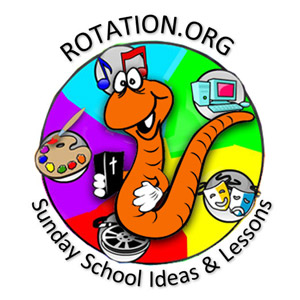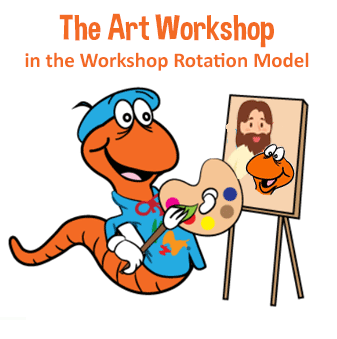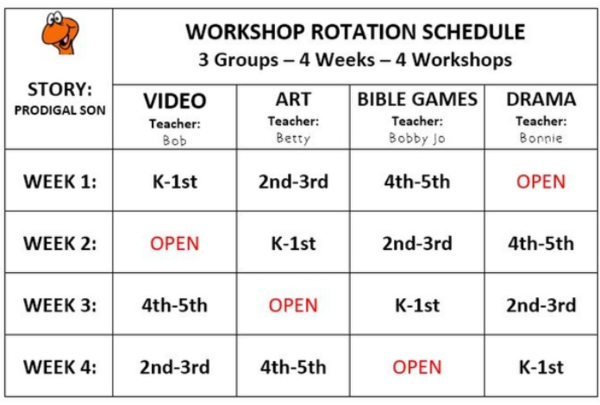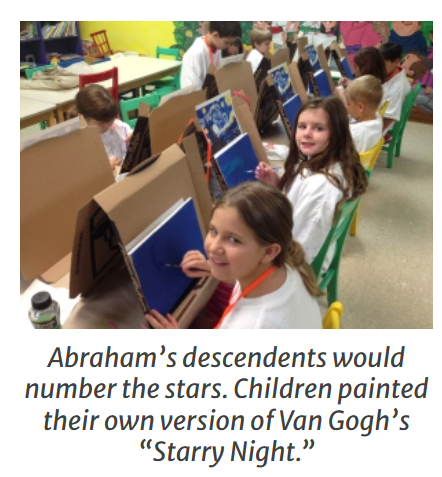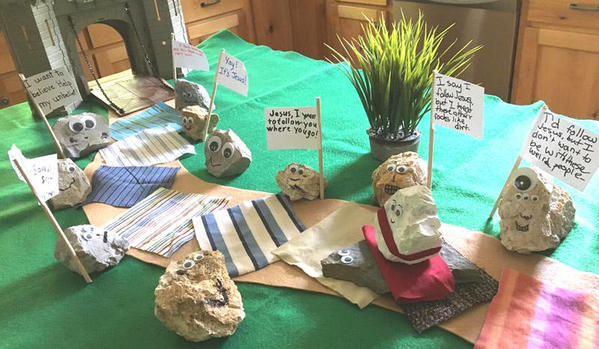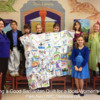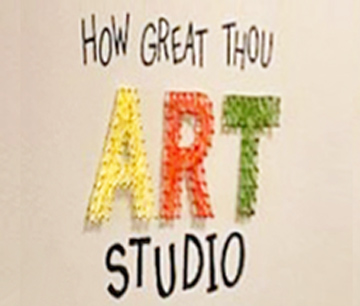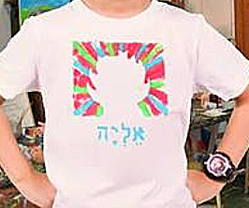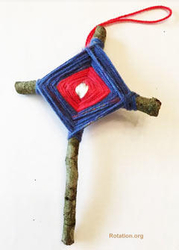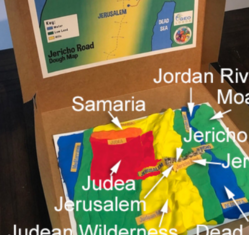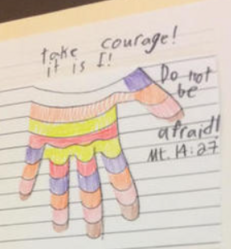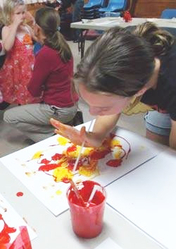Teaching with Art in the Rotation Model
Creating something that expresses your heart, mind, and soul about what you have learned from scripture is educational and spiritual gold.
The creative process itself "processes" and deepens what we have learned. We are indeed "wonderfully made."
Of course, expressing yourself through art materials like painting, foil sculptures, or creating a mosaic isn't the only way to do "art." You can also express yourself through drama, cooking, movement, writing, and all sorts of creative presentations and reflections -- which many of the other types of Rotation Workshops do. But creating something meaningful using "art supplies" is one of the best and most fun ways to do art with kids.
Emphasis on "meaningful."
The Art Workshop's creative activity is connected to the lesson, not appended to it to fill time or reduce fidgeting. Creative materials and techniques in the Art Workshop are best when they draw out each student's knowledge, thoughts, feelings, and point of view -- and give them an opportunity to share those things with others.
The creative process in the Art Workshop is guided by the teacher in a communal setting with other students. It is not a solitary pursuit or "do whatever" approach. Though teachers will demonstrate techniques and use of the materials, the Art Workshop is not an exercise in "imitating" what the teacher does. The teacher, the lesson plan, the materials, and the techniques are there to guide and challenge each student's individual expression and choices, which ultimately become points of discussion and sharing.
The Workshop Rotation Model embraces this higher view of teaching Bible stories through art, and the Rotation part of the Model creates a practical way to make creative Art Workshops easier to do.
Rotation.org aspires to host better lesson plans that use higher-quality artistic approaches to teach Bible stories. These aspirations are in direct contrast to the dumbed-down "quickie craft" and "coloring page" activities found in many Sunday School curriculums and websites.
Especially in these days of struggling attendance, we can't waste a single lesson on any more popsicle stick crafts.
We need and want attractive and engaging learning methods and materials.
Note: Many of the following descriptions and practices are going to make more sense if you know how the Rotation Model works. See a presentation about the Model. That said, any traditionally organized Sunday School can benefit from this "higher view" on the use of art in our lessons.
Further down in this topic is a collection of links to exemplary Art Workshop Lesson Plans written by our Writing Team.
The Art Workshop: A Special Place and Special Schedule
 The term "Workshop" in the Workshop Rotation Model describes the Model's assignment of teaching mediums to specific classrooms. Thus, an Art Workshop is focused on using creative art techniques as its major learning activity, and a Drama Workshop is focused on using drama techniques for its major activities.
The term "Workshop" in the Workshop Rotation Model describes the Model's assignment of teaching mediums to specific classrooms. Thus, an Art Workshop is focused on using creative art techniques as its major learning activity, and a Drama Workshop is focused on using drama techniques for its major activities.
Each "Workshop" is also decorated, supplied, furnished, and staffed to teach Bible stories through that specific medium.
- "Decorated," not generic. In the case of an art workshop, the classroom is decorated with artistically inspired materials, projects, artwork, and the like.
- "Supplied" with real art materials that take thought and time to work with, not construction paper and coloring pages.
- "Furnished" to get messy, with drying stations and room to spread out.
- "Staffed" with creative teachers who like exploring different artistic media and helping students express their understanding through art.
Because the Rotation Model designates a room or space to serve as the "permanent" Art Workshop, the room begins to accumulate and take on the patina of a creative space that excites the kids' senses and creates a feeling of anticipation as soon as they enter the room. Walls are covered with art and previous projects.
Because you have a dedicated Art Workshop space and want to encourage creativity, all your art supplies are on-hand in that one room -- not locked away in a closet or cabinet. And if you're using the Rotation Model, your materials and special setup don't need to be put away at the end of the lesson because next week you'll have a new group of kids in there repeating your lesson with you (with age-adjustments). By rotating the kids to different workshops each week, but not the teacher, and by staying with the same story for a four or five-week "rotation," the teacher gets better and better each week at delivering their lesson and doesn't have to prepare a new lesson every single week. And the kids get a rich immersion in the story.
A typical Workshop Rotation Schedule for three rotating groups spending four weeks on a story...
See more scheduling examples for smaller and larger Sunday Schools
Another benefit of the Art Workshop in the Rotation Model is that it allows us to "aim high" with art through lesson plans designed to put the creative activity at the CENTER of the lesson plan, rather than tacking something onto the end of class time to revive bored children and fill time (like traditional lessons do). See the "exemplary" Art Workshop lesson described below.
An Exemplary Sunday School Art Workshop Lesson
The Rotation.org Writing Team revised and posted a terrific Art Workshop lesson plan in their Psalm 8: "When I look at your heavens" lesson set. It's one of the best examples of the conjunction between artistic expression and learning a Bible story. Supporting Members can access that lesson, the full set, and all the Team's especially creative lesson plans.
Join here if you haven't already.
The Psalm 8 Art Workshop lesson demonstrates how art materials and artistic techniques can combine in a way that helps children express their understanding of the scripture while reinforcing key verses and life application. The materials are familiar and inexpensive, the "crayon-resist" technique is intriguing and age-adaptable, and the results are enjoyable and shareable. It may just be the most perfect Sunday School art lesson ever posted at Rotation.org.

Pictured above: The Psalm 8 art project uses a combination of "crayon resist" and watercolor. It connects the swirling/embracing style of Van Gogh's Starry Night with a key idea from a Hebrew phrase found in the Psalm itself and the feelings of wonder and praise that gazing up at God's crowning starry sky elicit.
Reimagining Your Classroom as an Art Workshop
Part of the attraction of an Art Workshop is how its creative space and materials begin to excite the learning senses and put kids in a creative mood. That can't happen in a "clean room" that has all the supplies locked up.
In the Art Workshop, your walls should display inspirational art and past art projects. The room should be bright, colorful, and inviting.

Unlike the traditional lesson's gluing together of construction paper crafts, in the Art Workshop you'll use a variety of artistic projects that will also create excitement. They can include painting, murals, weaving, and sculpture. Students may be working individually or working together. Children learn how to express their own thoughts by watching and listening to others, and by collaborating.
It's not uncommon to see art stools instead of traditional chairs around the Art Workshop's set of tables -- because art stools can be slid under the table and out of the way to allow students to work together when needed. Some churches' Art Workshops have creatively painted old wooden chairs, or come up with all sorts of creative ways to bring color and design to their tables and walls.
In the Art Workshop your supplies should not be locked up away from the kids. Sometimes, its the choice of art supplies themselves that becomes how the student connects with the ideas of the lesson. For example, use "feathers" to paint with in your Ruth Art lesson because of a key idea expressed by both Ruth and Boaz to each other (see the Writing Team's Ruth Art Workshop about that!).
You'll also want areas in your Art Workshop to dry, lay out, hang, and display student artwork.
In that very first Rotation Model Art Workshop, we told the Facilities Committee that we were probably going to get paint, glue, and glitter on their carpet -- but only in that one room -- and they were okay with that.
 If you share your art space with a preschool program or it's in the corner of fellowship hall, you'll have to solve some issues, but it can and is often being done. (Spread a tarp on the floor under your workspace, for example.)
If you share your art space with a preschool program or it's in the corner of fellowship hall, you'll have to solve some issues, but it can and is often being done. (Spread a tarp on the floor under your workspace, for example.)
Speaking of shared space.... In one small Sunday School, their Art Workshop was transformed the second week of every Rotation into a Video Workshop by dropping down a big screen and swapping the folding chairs for plastic Adirondack chairs. They called their art and video studio "The Lion's Studio." The sign in the hallway even sprouts a stuffed lion that all the kids pat as they go by.
The Difference between "Art" and "Craft"
In the early days of rotation.org, a bunch of us debated online the difference between "art" and "craft." It was more than an academic exercise. We were looking to stretch our teaching concepts and develop new art project ideas.
Definitions flew back and forth. Here is the result of that discussion:
Definition of a Sunday School ART activity:
A teacher helping students think about how they can express key idea(s), verses, and/or life application from a Bible story through the selecting and arrangement of materials in such a way as it expresses their understanding, reinforces their memory, and gives them something they can talk about if they are comfortable doing so.
Completed art projects tend to share a student's feelings about and reflect a key idea from the scripture.
They also tend to take time. Time allows the meaning of the scripture more time to marinate, and gives the teacher more time to add insights. A crayon-resist painting of you wondering and praising under God's Psalm 8 heavens, for example, takes time and a personal investment, and becomes something that can be talked about.
Definition of a Sunday School CRAFT activity:
A teacher telling their students to "cut along this line, glue here, and make it look like this."
Craft projects tend to produce objects from the story. A cottonball sheep from Psalm 23, for example. Crafts tend to be quick, and reveal little about the meaning of the story.
The difference between an Art and a Craft project
Craft projects tend to create objects or props from the story as reminders of it. Whereas Art projects tend to have students express the meaning of the story.
Craft projects tend to be simple. "Cut here, draw this, glue that." Whereas Art projects allow the students to make choices in what they want to express about the story from the materials and guidance given to them by the teacher.
Craft projects tend to all look the same. Art projects have a degree of individuality and self-expression.
Craft projects tend to take very little time because they have been designed for quick construction using simple supplies. Art projects need time to develop because the materials and process and outcome offer more possibilities for the student to choose from and express themselves with.
 Take for example the story of the Prodigal Son. A craft project might have the students cut out the figure of the father and son from construction paper or a printable to make paper puppets that the kids move around as a script or story is read. In essence, you've created a play with a prop, not art.
Take for example the story of the Prodigal Son. A craft project might have the students cut out the figure of the father and son from construction paper or a printable to make paper puppets that the kids move around as a script or story is read. In essence, you've created a play with a prop, not art.
 A Prodigal Son Art Workshop project, however, might have the students SCULPT the figure of the father and son out of wire or aluminum foil. They might be asked to make the prodigal figure look like themselves! And when they were done, the sculptures could be posed by the students to represent certain key attitudes in the story, such as "Give me my share" and "Father I have sinned against you" and how God poses when we confess to him. This is art that literally imitates life, or in our case, life application.
A Prodigal Son Art Workshop project, however, might have the students SCULPT the figure of the father and son out of wire or aluminum foil. They might be asked to make the prodigal figure look like themselves! And when they were done, the sculptures could be posed by the students to represent certain key attitudes in the story, such as "Give me my share" and "Father I have sinned against you" and how God poses when we confess to him. This is art that literally imitates life, or in our case, life application.
Craft project ideas can often be transformed into true art project.
In fact, many of the Art Workshop ideas you'll find at Rotation.org and in the Writing Team Art Workshop lessons started out as craft projects or with craft materials. We've simply gone the extra mile with them so that the kids can go the extra mile with our lessons.
For example, a craft that builds Noah's Ark from a shoebox and construction paper can be transformed into the reflection and life application about "What is the Ark we are surrounded with?" by labeling the planks with God's promises and the names of people you can depend on.
The following photo demonstrates how a simple "rock craft" project was re-purposed into an art project by having the kids turn a prop from the story of Jesus in Luke 19:40 ("even the rocks will sing!") into a life-applying MESSAGE display. A "craft" version of this project would have simply had the students create their own individual "singing" rocks to remind them of the scripture. An Art Workshop version of this project focuses on the message, and maybe even has the kids make one of the rocks look like THEMSELVES, including a sign about what they'd like to sing about God to others.
Art usually makes a statement.
The Art Workshop Teacher's Talking Point "Patter"
When you've let your kids loose with the materials and are giving them time to create their creations, the teacher in the Art Workshop will have time to circulate among students, encouraging them, asking questions, and making suggestions.
This creative time in the lesson is a great time to build kids up, and get them to share some of the things they are thinking of with other students.
This creative time is also a great opportunity to make comments about the story, reinforce key points, ask discussion questions, and share interesting Bible Background.
"Patter Time" is not time to run around and figure out supplies or clean up. Prepare ahead and clean up later! Invariably kids will need help with the supplies and techniques, and this is a great opportunity to get pastoral. But if your project requires a lot of the teacher's "hands-on," get help.
Don't be afraid to help students rethink their work, develop a better expression, start over, and make changes. Our goal is not for them to "do whatever." Rather, our goal is to guide them to create a recognizable expression of the meaning our lesson seeks to guide them to in the scripture. Unlike "an art class," which introduces techniques and encourages free expression, we have a content goal in mind. The experience of creating art is wonderful, but it's not the whole enchilada.
Sharing completed art projects is also a great reflection activity.
Many Writing Team Art Workshop lesson plans and other publicly available lesson plans here at Rotation.org have "Talking Points" (patter) built right into them.
The "State of Art" in Various Rotation.org Lessons
Not every art workshop at Rotation.org has a higher standard of "art" over craft. As a sharing community, we have let people post what they think works, while at the same time trying to demonstrate a higher standard, one that moves beyond the quickie crafts you see elsewhere.
Many of the ideas for "art" projects listed in this forum and through the lesson forums here at rotation.org are familiar and "old-school." We have RECYCLED many great art project ideas found in creative curriculum throughout the years, and in many cases, tried to improve on them -- make them more artistic.
Our Writing Team Lesson Sets, however, DO hold to a higher artistic standard, each one demonstrating how to use materials and techniques to express God's Word in a deeper more memorable way.
Art Projects Usually Have a Wider Age Range than Craft Projects
If you are using those printable crafts or craft kits from a published curriculum, they need to sell you a simpler one for the younger kids, and one that "looks older" for the older kids.
Whereas most art materials, like foil sculpturing and painting, ADAPT in the hands of the user. This is one of the great advantages of teaching with real art materials.
That said, some art materials are age-senstive. Older kids like to use more "grown up" materials and may balk at crayons unless you use them in a "wax resist" or other unexpected manner.
The picture above of the Cotton Ball Sheep illustrates the problem of so many "craft" project materials that older kids will balk at because they think it's for "little kids."
Art Projects in the Rotation Model Art Workshop are not completely open-ended.
If you give kids too little direction and too few examples and ideas, they will often end up painting a big blob of paint. If you ask them to paint a picture of God's love, you'll get a lot of red hearts and rainbows.
The Art Workshop in the Rotation Model is not "creativity for creativity's sake." Our purpose is to help them produce a sacred expression from their heart and mind about the lesson we are teaching. We're not primarily teaching the joy of painting. We're teaching them how to express their understanding through the materials and techniques we selected.
This painting project from the Writing Team's Ruth lesson set Art Workshop is a good example of walking the line between giving them creative freedom and producing an outcome that resembles a key idea that we want them to reflect on and remember.

In their painting, they use feathers which are an important allusion to God's protection that comes straight from the Ruth scripture itself. We asked them to experiment with stamping and painting with their feather to create a visual embrace, a surrounding of protection (which Boaz offered to Ruth, which Ruth asked Boaz for on the threshing floor, which Ruth demonstrated to Naomi, and Ruth gave Naomi, and which God was giving the Israelites through this family which would produce David). And we gave them options and examples of several other techniques and objects they could include, such as painting with a gleaned wheat stalk, and painting your family into God's embrace. See the lesson for many more details and suggestions related to this Ruth Art Workshop!
Art, of course, is in the eye of the beholder. Those of us seeking better use of arts and crafts in Sunday School continue to strive and experiment. And you'll see many of those ideas in the Art Workshop forums here in our Bible Lesson Forums, as well as some very thoughtful and complete Art Workshop lesson plans from our Writing Team.
Just pick your Bible story and look up its Art Workshop suggestions.
And if you have something to add or ask, please do!
This article has been compiled and updated based on the original Art Workshop "how-to" discussion contributed by Rotation Model pioneers "Creative Carol" Hulbert, Neil MacQueen, Lisa Martin, and several others. You are welcome to copy and use it with your teachers.
